NVIDIA’s GeForce GTX 480 and GTX 470: 6 Months Late, Was It Worth the Wait?
by Ryan Smith on March 26, 2010 7:00 PM EST- Posted in
- GPUs
Compute
Update 3/30/2010: After hearing word after the launch that NVIDIA has artificially capped the GTX 400 series' double precision (FP64) performance, we asked NVIDIA for confirmation. NVIDIA has confirmed it - the GTX 400 series' FP64 performance is capped at 1/8th (12.5%) of its FP32 performance, as opposed to what the hardware natively can do of 1/2 (50%) FP32. This is a market segmentation choice - Tesla of course will not be handicapped in this manner. All of our compute benchmarks are FP32 based, so they remain unaffected by this cap.
Continuing at our look at compute performance, we’re moving on to more generalized compute tasks. GPGPU has long been heralded as the next big thing for GPUs, as in the right hands at the right task they will be much faster than a CPU would be. Fermi in turn is a serious bet on GPGPU/HPC use of the GPU, as a number of architectural tweaks went in to Fermi to get the most out of it as a compute platform. The GTX 480 in turn may be targeted as a gaming product, but it has the capability to be a GPGPU powerhouse when given the right task.
The downside to GPGPU use however is that a great deal of GPGPU applications are specialized number-crunching programs for business use. The consumer side of GPGPU continues to be underrepresented, both due to a lack of obvious, high-profile tasks that would be well-suited for GPGPU use, and due to fragmentation in the marketplace due to competing APIs. OpenCL and DirectCompute will slowly solve the API issue, but there is still the matter of getting consumer orientated GPGPU applications out in the first place.
With the introduction of OpenCL last year, we were hoping by the time Fermi was launched that we would see some suitable consumer applications that would help us evaluate the compute capabilities of both AMD and NVIDIA’s cards. That has yet to come to pass, so at this point we’re basically left with synthetic benchmarks for doing cross-GPU comparisons. With that in mind we’ve run a couple of different things, but the results should be taken with a grain of salt as they don’t represent any single truth about compute performance on NVIDIA or AMD’s cards.
Out of our two OpenCL benchmarks, we’ll start with an OpenCL implementation of an N-Queens solver from PCChen of Beyond3D. This benchmark uses OpenCL to find the number of solutions for the N-Queens problem for a board of a given size, with a time measured in seconds. For this test we use a 17x17 board, and measure the time it takes to generate all of the solutions.
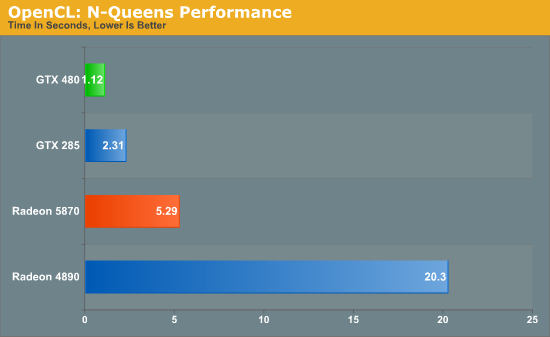
This benchmark offers a distinct advantage to NVIDIA GPUs, with the GTX cards not only beating their AMD counterparts, but the GTX 285 also beating the Radeon 5870. Due to the significant underlying differences of AMD and NVIDIA’s shaders, even with a common API like OpenCL the nature of the algorithm still plays a big part in the performance of the resulting code, so that may be what we’re seeing here. In any case, the GTX 480 is the fastest of the GPUs by far, beating out the GTX 285 by over half the time, and coming in nearly 5 times faster than the Radeon 5870.
Our second OpenCL benchmark is a post-processing benchmark from the GPU Caps Viewer utility. Here a torus is drawn using OpenGL, and then an OpenCL shader is used to apply post-processing to the image. Here we measure the framerate of the process.
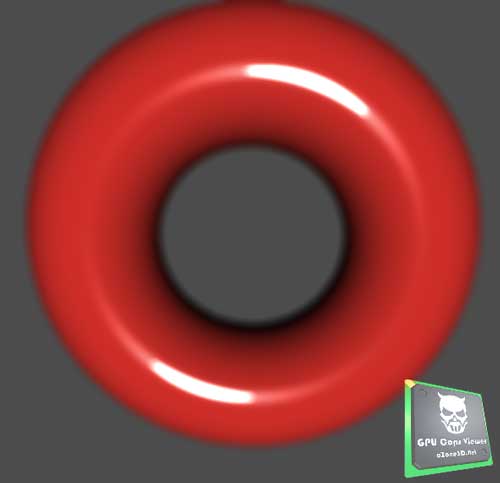
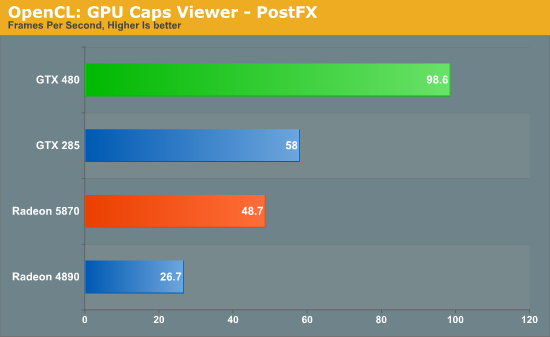
Once again the NVIDIA cards do exceptionally well here. The GTX 480 is the clear winner, while even the GTX 285 beats out both Radeon cards. This could once again be the nature of the algorithm, or it could be that the GeForce cards really are that much better at OpenCL processing. These results are going to be worth keeping in mind as real OpenCL applications eventually start arriving.
Moving on from cross-GPU benchmarks, we turn our attention to CUDA benchmarks. Better established than OpenCL, CUDA has several real GPGPU applications, with the limit being that we can’t bring the Radeons in to the fold here. So we can see how much faster the GTX 480 is over the GTX 285, but not how this compares to AMD’s cards.
We’ll start with Badaboom, Elemental Technologies’ GPU-accelerated video encoder for CUDA. Here we are encoding a 2 minute 1080i clip and measuring the framerate of the encoding process.
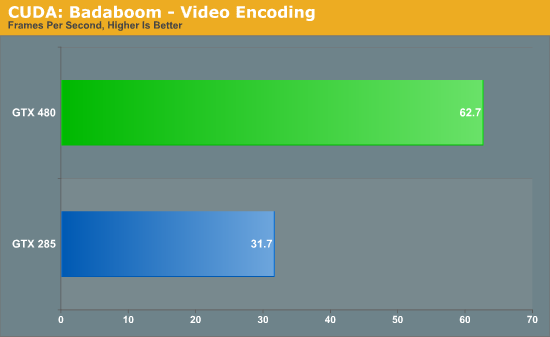
The performance difference with Badaboom is rather straightforward. We have twice the shaders running at similar clockspeeds, and as a result we get twice the performance. The GTX 480 encodes our test clip in a little over half the time it took the GTX 280.
Up next is a special benchmark version of Folding@Home that has added Fermi compatibility. Folding@Home is a Standford research project that simulates protein folding in order to better understand how misfolded proteins lead to diseases. It has been a poster child of GPGPU use, having been made available on GPUs as early as 2006 as a Close-To-Metal application for AMD’s X1K series of GPUs. Here we’re measuring the time it takes to fully process a sample work unit so that we can project how many nodes (units of work) a GPU could complete per day when running Folding@Home.

Folding@Home is the first benchmark we’ve seen that really showcases the compute potential for Fermi. Unlike everything else which has the GTX 480 running twice as fast as the GTX 285, the GTX 480 is a fewtimes faster than the GTX 285 when it comes to folding. Here a GTX 480 would get roughly 3.5x as much work done per day as a GTX 285. And while this is admittedly more of a business/science application than it is a home user application (even if it’s home users running it), it gives us a glance at what Fermi is capable when it comes to compuete.
Last, but not least for our look at compute, we have another tech demo from NVIDIA. This one is called Design Garage, and it’s a ray tracing tech demo that we first saw at CES. Ray tracing has come in to popularity as of late thanks in large part to Intel, who has been pushing the concept both as part of their CPU showcases and as part of their Larrabee project.

In turn, Design Garage is a GPU-powered ray tracing demo, which uses ray tracing to draw and illuminate a variety of cars. If you’ve never seen ray tracing before it looks quite good, but it’s also quite resource intensive. Even with a GTX 480, with the high quality rendering mode we only get a couple of frames per second.
On a competitive note, it’s interesting to see NVIDIA try to go after ray tracing since that has been Intel’s thing. Certainly they don’t want to let Intel run around unchecked in case ray tracing and Larrabee do take off, but at the same time it’s rasterization and not ray tracing that is Intel’s weak spot. At this point in time it wouldn’t necessarily be a good thing for NVIDIA if ray tracing suddenly took off.
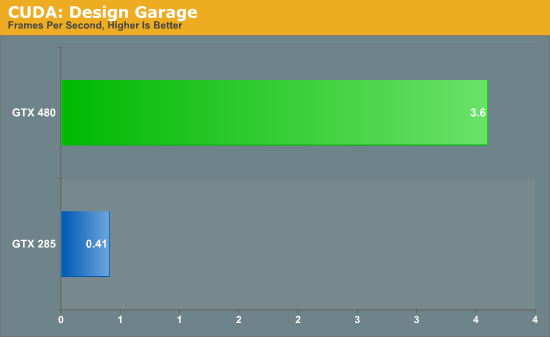
Much like the Folding@Home demo, this is one of the best compute demos for Fermi. Compared to our GTX 285, the GTX 480 is eight times faster at the task. A lot of this comes down to Fermi’s redesigned cache, as ray tracing as a high rate of cache hits which help to avoid hitting up the GPU’s main memory any more than necessary. Programs that benefit from Fermi’s optimizations to cache, concurrency, and fast task switching apparently stand to gain the most in the move from GT200 to Fermi.










196 Comments
View All Comments
nyran125 - Monday, April 12, 2010 - link
Im going wiht the less power hungry ati 5000 series. I know a 5850 card will easily fit in my Case aswell. There no way id choose the GTX 470 over any of the ati s870 or 5850 cards. So that only leaves the GTX 480 against either the 5870 or the 5850. The performance increase and power increase is NOT worth me paying for a nvidia card thats higher in price over the 5870.I meen even looking at the games. The games ill probably play Crysis adn BAttlefield bad company 2 come out on top of the nivdia 480 GTX. so bla.
Nvidia you need to make a much bette rcard than that fo rme to spend money on a GTX 470 or GTX 480 ove rthe 5870 or 5850.
nyran125 - Monday, April 12, 2010 - link
oh and secondly, if your buying a 200 series nivida card or the GTX 480 it isnt fast enough to future proof your computer. You might aswell go spend less money on a 5970 or a single 5870 you know it will last for the next 2 years and the GTX 480 will NOT last any longer than teh 5000 series with its 10-15% performance increase. I didnt like the 200 series nvidia cards and im not interested in even MORE power hungry cards that. I want less power hungry cards and efficiency. To me a game plays bugger all different with 60 FPS average and 100 fps average. If you have a 200 series card save your money and wait for the next gen of cards or at least wait till a DX 11 game actualyl comes out not just Just cause friggin 2..vagos - Thursday, April 15, 2010 - link
ok all theese cards are nice. new technology is very welcome. but where is the games to push them?? if i spent 400$ or 500$ on a new card where i could see a really big difference against my old 8800GT?? they sell hardware without software to support it...2 or 3 games makes no difference to me. ps3 an xbox360 have very old graphic cards compared to ati 5800 series and nvidia 400 and still tha games are looking beautifull. an in some cases mauch better than on pc...make new games for pc and then i will buy a new card! until then i will stuck with my xbox360...
Drizzit101 - Sunday, May 9, 2010 - link
I have been running the GTX 295. The plan was to buy a second GTX 295. Looking at the prices, I was thinking about just buying two GTX 470's. What the better move?Krazy Glew - Tuesday, May 11, 2010 - link
See http://semipublic.comp-arch.net/wiki/Poor_Man%27s_...In particular
US patent 7,117,421, Transparent error correction code memory system and method,
Danilak,
assigned to Nvidia,
2002.
http://semipublic.comp-arch.net/wiki/Poor_Man%27s_...
Matt Campbell - Monday, August 2, 2010 - link
Ryan, what was the special sauce you used to get Badaboom working on Fermi? My GTX 460 won't run it, and Elemental's website says Fermi support won't get added until Q4 2010. http://badaboomit.com/node/507niceboy60 - Friday, August 20, 2010 - link
I have the same probleme on my GTX 480 , Badaboom does not work on fermi ,according with my own experience and Badaboom official web siteI dont think this benchmarks are accurate
niceboy60 - Friday, August 20, 2010 - link
I bought a GTX 480 based on this review as I do a considerable amount of video convertingJust to find out ,dispite the GTX 480 is showing very good resaults when using Badaboom
The truth is Badaboom is not compatible yet with any GTX 400 series according with The badaboom web site .
adder1971 - Friday, September 17, 2010 - link
The Badaboom website says it does not work and when I try it with the GTX 465 it does not work. How were you able to get it to work? I have the NVIDIA latest release drivers as of today and the latest released version of Badaboom.wizardking - Tuesday, September 21, 2010 - link
I bought this card for it only ! I used badaboom with number which you use !!!!!!